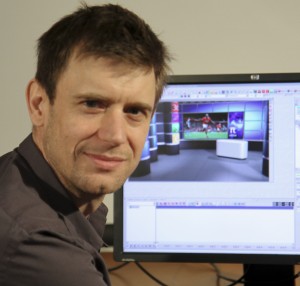Guest Comment: 2017 and the future of the graphics industry

Luke Harrison, Technical Product Marketing Manager, RT Software: “One of the biggest trends we are seeing at the moment is take up of 4K/UHD production.”
The broadcast, media and entertainment industry is one that doesn’t stand still, writes Luke Harrison, Technical Product Marketing Manager, RT Software. Driven by an almost insatiable demand from consumers, changes in technology and seeking new ways in which to monetise content, the landscape is fast-evolving. When it comes to consumers, they are not only influencing the types of content that are created and made available, but increasingly the quality of that content – particularly in the live production space.
Viewing has become a more engaging process where audiences interact with content and, as a result, stay around longer to consume it. If it doesn’t hold their interest in terms of quality or relevance, then they simply change the channel, device or OTT service. In the live content arena, particularly sports broadcasting, there’s an increased appetite for graphics – whether that is in delivering post-match analysis, showing statistics and tables during the match or presenting player profiles and team line-ups beforehand.
One of the biggest trends we are seeing at the moment is take up of 4K/UHD production. This naturally forces a technology refresh and we were amongst the first with suitable graphics systems for live production. Associated with this is the need to preserve full colour depth throughout the broadcast chain. In the first instance, this entailed support for full 10bit processing to maintain full colour depth through the render process. In addition, the advent of HDR will push this requirement further to 12/14 and even 16 bit resolution along with changing colour gamut requirements such as rec BT.2020. In order to support these changes we needed a graphics pipeline that was flexible and adaptable in both render and output. Full, real-time floating point render with a plugin approach to colour space conversion has ensured we can meet these challenges both now and in the future.
We are all aware that sports graphics solutions have played a key role on sporting shows for several years. Now, using the same technology that applies to virtual studios, augmented reality (AR) is giving audiences live views of a physical, real-world environment that has been enhanced with additional computer-generated elements such as sound, video and graphics. The use of high quality rendering such as PBR and diffuse lighting provides realistic elements that form part of the set.
Behind the scenes, the introduction of IP workflows is having a huge impact on production environments and operations. We all know that there is huge interest in how IP will impact workflows, from live contribution to distribution – particularly around evolving standards. It is not, of course, all happening overnight, but its adoption is building momentum and at some not-too-distant point in the future the entire broadcast ecosystem is going to be based on IP.
When it comes to rendering and live graphics, the arrival and continued adoption of IP as a standard method of transporting signals is also having a tremendous impact. One of the biggest changes we are seeing at the moment, something that will only grow in 2017, is the use of IP to make rendering more efficient and cost-effective.
With the adoption of IP workflows comes another technology that is already being exploited in the broadcast playout centre: virtualization. Reducing hardware footprint whilst maximising output has seen a huge boost with the advent of virtualized technology coupled with virtualized graphics. The advantages of reduced operating costs and redundancy combined with flexibility means new channels can be created – literally – with the click of a button. Temporary channels can be created on demand for large sporting events with costs reduced to cover only the that usage.
This is something that RT Software has successfully demonstrated at both NAB and IBC. Two things are crucial to fully unlock the potential of virtualization + IP. The first is a ‘lean and mean’ render engine, dedicated to providing graphics with as little CPU/GPU overhead as possible. The second is the adoption of web-based command and control that provides front ends anywhere in the connected world.
The adoption of HTML5 allows thin client installs in gallery situations, while virtualized CPUs also provide data storage, media asset management, NewsRoom control and more —all integrated within a scalable, redundant virtualized environment. The concept of ‘Newsroom in a Box’ is fast becoming a reality.
More and more organisations will move towards adopting this trend, especially as IP makes it easier to distribute video across the facility. Other benefits of having an IP-based infrastructure include added flexibility and simplicity. Just think about cabling — using IP there is no need for SDI cables for each video stream, so workspaces are clearer and it also becomes easier to scale up (or down). Once the infrastructure is in place, organisations can be more agile and versatile. If you wanted to upgrade, increase input, or migrate to different formats, you wouldn’t need to change the infrastructure and start from scratch again.
Looking to the year ahead, IP and its continued adoption will be a driving force of change, regardless of where that is within the broadcast workflow or application. For graphics, streamlining operations and making the rendering process more efficient and cost-effective, will be one area where broadcasters will definitely look to capitalise on.
